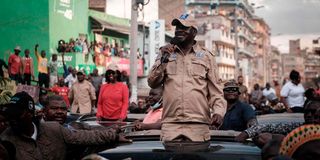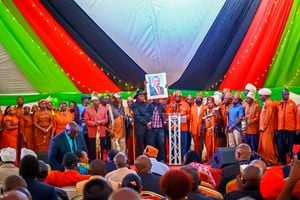Maandamano, Raila’s chaotic platform, fizzles out in an anaemic whimper

Opposition leader Raila Odinga.
In the end, maandamano fizzled out to mere nuisance and a form of nagging background irritation, instead of escalating into a cataclysmic insurgency that, as Raila Odinga and his colleagues promised, would humble Kenya Kwanza and bring a grovelling, humiliated President William Ruto to the negotiating table.
Previous instalments of maandamano had assaulted the nation with cacophonous spectacles of random criminality, wanton violence, ferocious menace and the confident swagger of ubiquitous impunity.
Azimio la Umoja made it clear that such were the parameters of successful maandamano that they appreciated and wished to see in every episode of ‘peaceful protest’.
Lay in ruins
In the aftermath, businesses lay in ruins, infrastructure vandalised, innocent people traumatised and normal activity paralysed.
When Odinga called off protests over Easter to give bipartisan parliamentary engagements a chance, he made it clear that he wielded absolute power to resort to devastating mayhem whenever it suited him, and that the government was utterly powerless to stop them.
Naturally, we all expected the resumption of maandamano to end normalcy as we have known it, perhaps for good.
That was not to be. Azimio found the national security apparatus at its most present, effective, coordinated and prepared. It was a shock, which turned the dynamic around and promptly drove bewildered Azimio leaders underground.
It is now known that many Azimio politicians found excuses to be out of the country or indisposed, with a good number said to have admitted themselves into hospital in order to be excused from mandatory participation in protests. Very few could be found at their customary addresses.
Uncompromising security deployment on one hand, and cowardice of their leaders, systematically demoralised many protestors. Azimio goons, who usually take reckless risks for the cause, realised that the political cover which emboldened them was a treacherous mirage.
Consequently, the maandamano began with reticent bravado, hesitant menace and tentative ebullience, and subsequently diminished into the half-hearted derring-do of anomalously risk-averse thugs.
Normalcy reasserted itself with a vengeance, schools and businesses reopened. Azimio became a dull, indecisive, dwindling threat, like the bark of a timorous hound. All that remained was for Azimio leaders to call the thing off, but they would not. Instead, some travelled out of town as others claimed to be under arrest.
The death of maandamano was a bipartisan undertaking by wananchi universally fed up with the anxiety they have been subjected to by politician addled with cognitive dissonance.
As a strategy, maandamano was disruptive, yet incompatible with the reasons and objectives for which they were convened. There is no clear connection between the cost of living, which has been cynically escalated as the foremost grievance animating the protests, and rioting and looting as a solution.
Damage to limousines
Exhausted and hungry Azimio supporters, who had sacrificed entire days of gainful employment, returned home to destitution as their leaders protested over damage to limousines and the withdrawal of security detail from plush milieux.
The robust security response simultaneously undermined Azimio’s riotous capacity and emboldened the general population to resume normalcy.
Some even confidently mobilised their own peaceful protests against maandamano!
In earlier episodes, the security response had been disjointed, unmotivated, poorly coordinated and anaemic. The cost of delinquency has risen steeply, and since peaceful protest is neither Azimio’s strategy or purpose, maandamano as customarily convened, was utterly untenable.
The most decisive factor in the collapse of maandamano was, naturally, Raila Odinga. He understands protest differently, and certainly not a means of democratic self-expression in order to engage government and other authorities.
Odinga is a prodigious exploiter of the attention economy, and protest is his platform. He is not interested in the staid civilities of formal processions. Odinga prefers spectacle: sound and fury, shock and awe, noise and movement.
Helter-skelter, is Odinga’s stock in trade. His longevity in opposition politics, and his unaccountably unassailable profile as the ultimate doyen of liberation politics eclipses everyone else, including personages of more consequential pedigree.
Centre of attention
The reason is that Odinga understands one thing about public affairs: it is not enough to do the work; in fact, it may not even be necessary to do the work. The main thing is to claim and appropriate all credit, and the only way to plausibly do this is by staying at the front and centre of national attention.
A protest-driven politics is therefore Odinga’s most efficient way of sustaining himself and incrementally elevating his stature above all illustrious ideologues, fabulous altruists, selfless warriors, brave freedom fighters and every other worthwhile competitor, and effectively dominate the national psyche for generations.
Any agitation, protest or other political ferment that does not feature Odinga in active frontline combat is a dangerously unwise action. If other people are going to be more visible and audible during protests, it is not ideal.
Worse still, if any exigency denies Odinga his moment at the centre of the spectacle, it is a lost cause.
Last week, a desperately vocal social media presence was all Odinga could manage. These are maandamano to forget quickly.
- Mr Ng’eno is an Advocate of the High Court of Kenya.





